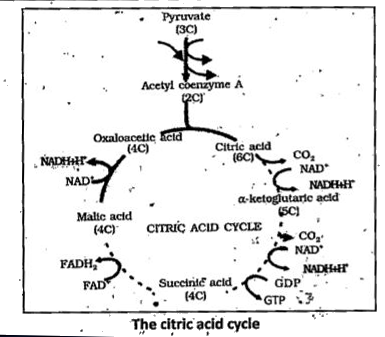Explain the reactions of Kreb's cycle. Solution in Telugu
Video Solution
Text Solution
The reaction sequence of Kreb.s cycle is as below.
1. Condensation : Acetyl co-enzyme A condenses with oxaloacetic acid and results in the formation of citric acid and co-enzyme-A. This condensation reaction is catalysed by the enzyme .citric synthetase.
Oxaloacetic acid + Acetyl CoA Citric Synthetase−−−−−−−−−→ Citric acid + Coenzyme A.
2. Dehydration : The enzyme .aconitase. catalyses the removal of one molecule of water from citric acid leading to the formation of cis-aconitic acid.
Citric acid Aconitase−−−−−→ Cis - aconitic acid + H2O
3. Hydration : Addition of one molecule of water is done in the presence of aconitase Cis-aconitic acid forms Isocitric acid.
Cis-aconitic acid +H2OAconitase−−−−−→ isocitric acid.
4. Oxidation - I : Isocitric - acid undergoes dehydrogenation (oxidation) in the presence of .isocitric dehydrogenase. enzyme, leading to the formation of oxalosuccinic acid. In this reaction NAD is reduced to NADH + H+.
Isocitric acid + NAD + isocitric dehydrogenase−−−−−−−−−−−−−→ Oxalosuccinic acid +NADH+H+
5. Decarboxylation : Oxalosuccinic acid releases one molecule : of CO2 in the presence of oxalosuccinic decarboxylase enzyme and forms α ketoglutaric acid.
Oxalosuccinic acid Oxalosuccinic decarboxylase−−−−−−−−−−−−−−−−→α -ketoglutaric acid. +CO2
6. Oxidation - II : α - ketoglutaric acid undergoes oxidation (dehydrogenase) decarboxylation and condensation with one molecule of CoA leading to the formation of succinyl coenzyme A.
α - Ketoglutaric acid + NAD + Coenzyme A α−ketoglutaric dehydrogenase−−−−−−−−−−−−−−−−−−→
→ Succinyl conenzyme A+NADH+CO2
7. Cleavage : Succinyl coenzyme A splits into succinic acid and coenzyme A by the enzyme activity of succinic acid thiokinase. Energy released in this reaction is utilised to form ATP from ADP and inorganic phosphate.
Succinyl coenzyme A + ADP + Pi Succinic thiokinase−−−−−−−−−−−−−−−−→Succinic acid + ATP + CoA
8. Oxidation II : Succinic acid then undergoes oxidation and forms Fumeric acid. Instead of NAD+ , FAD serves as hydrogen acceptor in this reaction. Therefore FAD is reduced to FADH,. The enzyme which catalyses this reaction is known as succinic dehydrogenase.
Succinic acid +FADSuccinic dehydrogenase −−−−−−−−−−−−−−→ Fumeric acid +FADH2
9 Hydration: The enzyme Fumerase mediates the addition of one water molecule to fumeric aicd leads to the formation of malic aicd.
Fumeric acid H2OFumerase−−−−−→ Malic acid.
10. Oxidation IV : In the presence of Malic dehydrogenase, Malic acid releases two hydrogen atoms and gives rise to oxaloacetic .acid. In this step NAD+ acts as hydrogen acceptor and is y converted into NADH +H+
, Malic acid + NAD + Malic dehydrogenase−−−−−−−−−−−→ Oxaloacetic acid +NADH+H+

|
Updated on:21/07/2023
Topper's Solved these Questions
Similar Questions
How does ascent of sap occur in tall trees ?
View SolutionDescribe the structure of the heart of man with the help of neat labelled diagram.
View SolutionGive an account of glycolysis, Where does it occur ? What are the end products? Trace the fate of these products in both aerobic, and anaerobic respiration.
06:58View SolutionIn Kreb's cycle
04:50View SolutionKreb's cycle
03:40View SolutionExplain the Kreb's cycle with reaction.
45:30View SolutionThe first reaction of Kreb's cycle includes:
48:37View SolutionExplain the anabolic nature of Kreb's cycle.
08:12View SolutionLink Reaction|Introduction to Kreb's Cycle
08:54View SolutionKreb's Cycle
03:32View SolutionExplain the Kreb's cycle with reaction.
02:48View SolutionAnswer in detail: Explain glycolysis and Kreb's cycle in detail.
02:37View SolutionIn Kreb's cycle
01:08:06View SolutionKreb's cycle
View SolutionWhat is Kreb's cycle? Explain briefly.
03:56View SolutionKreb's Cycle
03:05View Solution

